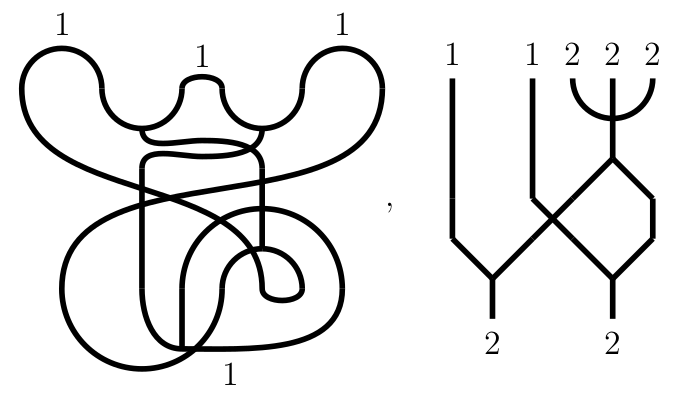Data
- Title: Orthogonal webs and semisimplification
- Authors: Elijah Bodish and Daniel Tubbenhauer
- Status: Comb. Theory 5 (2025), no. 3, Paper No. 12, 76 pp. Last update: Tue, 2 Sep 2025 19:03:23 EST
- ArXiv link: https://arxiv.org/abs/2401.00704
Abstract
We define a diagrammatic category that is equivalent to tilting representations for the orthogonal group. Our construction works in characteristic not equal to two. We also describe the semisimplification of this category.
A few extra words
In this paper we define a diagrammatic category of orthogonal webs
that is equivalent to tilting representations of the orthogonal group.
A closed orthogonal pre-web is a trivalent graph with edges labeled
with integers \(\{1,\dots,N\}\)
such that we have \(k\), \(l\) and \(k+l\) around
every trivalent vertex. A closed orthogonal web
is an immersion of a closed orthogonal pre-web such that each
point of intersection is a crossing in the usual sense.
As usual in diagrammatic algebra, cutting these graphs open and putting
them into a strip with bottom and top boundary points gives a way to define morphisms, called orthogonal webs, in a monoidal category.
Here are two examples, the left one being closed:

Summarized, we:
- Fix \(p=0\) or any prime \(p\) not equal to \(2\). Let \(\mathbb{F}\) be an infinite field of characteristic \(p\) containing \(\sqrt{-1}\).
- We give a diagrammatic presentation of tilting \(O_{N}(\mathbb{F})\)-representations using orthogonal webs. This extends the result of Sartori to prime characteristic.
- A main ingredient is Howe's orthogonal duality in prime characteristic.
- As an application we describe the semisimplification of tilting \(O_{N}(\mathbb{F})\)-representations. Here \(p\neq 2\) is arbitrary and does not need to be bigger than \(N\).
